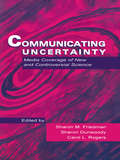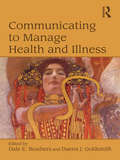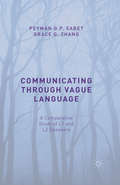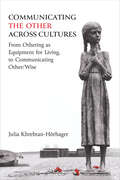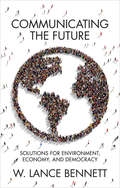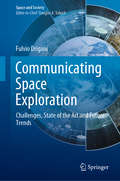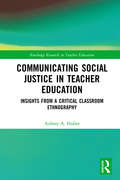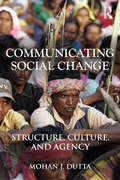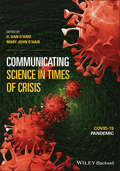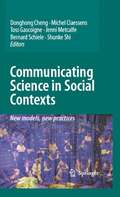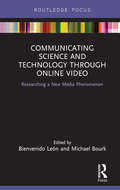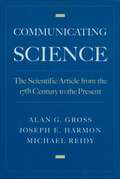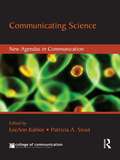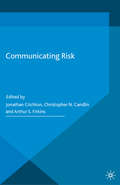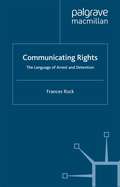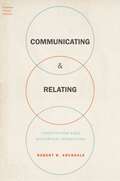- Table View
- List View
Communicating Uncertainty: Media Coverage of New and Controversial Science
by Sharon M. Friedman Sharon Dunwoody Carol L. RogersExploring the interactions that swirl around scientific uncertainty and its coverage by the mass media, this volume breaks new ground by looking at these issues from three different perspectives: that of communication scholars who have studied uncertainty in a number of ways; that of science journalists who have covered these issues; and that of scientists who have been actively involved in researching uncertain science and talking to reporters about it. In particular, Communicating Uncertainty examines how well the mass media convey to the public the complexities, ambiguities, and controversies that are part of scientific uncertainty. In addition to its new approach to scientific uncertainty and mass media interactions, this book distinguishes itself in the quality of work it assembles by some of the best known science communication scholars in the world. This volume continues the exploration of interactions between scientists and journalists that the three coeditors first documented in their highly successful volume, Scientists and Journalists: Reporting Science as News, which was used for many years as a text in science journalism courses around the world.
Communicating Uncertainty: Media Coverage of New and Controversial Science
by Sharon M. Friedman Sharon Dunwoody Carol L. RogersExploring the interactions that swirl around scientific uncertainty and its coverage by the mass media, this volume breaks new ground by looking at these issues from three different perspectives: that of communication scholars who have studied uncertainty in a number of ways; that of science journalists who have covered these issues; and that of scientists who have been actively involved in researching uncertain science and talking to reporters about it. In particular, Communicating Uncertainty examines how well the mass media convey to the public the complexities, ambiguities, and controversies that are part of scientific uncertainty. In addition to its new approach to scientific uncertainty and mass media interactions, this book distinguishes itself in the quality of work it assembles by some of the best known science communication scholars in the world. This volume continues the exploration of interactions between scientists and journalists that the three coeditors first documented in their highly successful volume, Scientists and Journalists: Reporting Science as News, which was used for many years as a text in science journalism courses around the world.
Communicating to Manage Health and Illness
by Dale E. Brashers Daena GoldsmithCommunicating to Manage Health and Illness is a valuable resource for those in the field of health and interpersonal communication, public health, medicine, and related health disciplines. This scholarly edited volume advances the theoretical bases of health communication in two key areas: 1) communication, identity, and relationships; and 2) health care provider patient interaction. Chapters aim to underscore the theory that communication processes are a link between personal, social, cultural, and institutional factors and various facets of health and illness. Contributors to the work are respected scholars from the fields of communication, public health, medicine nursing, psychology, and other areas, and focus on ways in which patient identity is communicated in health-related interactions. This book serves as an excellent reference tool and is a substantial addition to health communication literature.
Communicating to Manage Health and Illness
by Dale E. Brashers Daena GoldsmithCommunicating to Manage Health and Illness is a valuable resource for those in the field of health and interpersonal communication, public health, medicine, and related health disciplines. This scholarly edited volume advances the theoretical bases of health communication in two key areas: 1) communication, identity, and relationships; and 2) health care provider patient interaction. Chapters aim to underscore the theory that communication processes are a link between personal, social, cultural, and institutional factors and various facets of health and illness. Contributors to the work are respected scholars from the fields of communication, public health, medicine nursing, psychology, and other areas, and focus on ways in which patient identity is communicated in health-related interactions. This book serves as an excellent reference tool and is a substantial addition to health communication literature.
Communicating through Vague Language: A Comparative Study of L1 and L2 Speakers
by Grace Q. Zhang Peyman G.P. SabetThis book is a comparative study of vague language based on naturally occurring data of L1 and L2 speakers in academic settings. It explores how L2 learners have diverse and culturally specific needs for vague language compared with L1s, and are generally vaguer.
Communicating the Other across Cultures: From Othering as Equipment for Living, to Communicating Other/Wise
by Julia Khrebtan-HörhagerWhenever political and social decisions use categories of identity such as race, religion, social class, or nationality to distinguish groups of people, they risk holding certain groups as inferior and culturally “Other.” When people employ ideologies of imperialism, colonialism, patriarchy, and classism, they position certain groups as superior or ideal/ized people. Such ideological positioning causes nations to take actions that isolate or endanger minoritized populations. This cultural Othering can lead to atrocities such as Native Americans being expelled from their native lands through the Trail of Tears, millions of Ukrainians starving to death during the Holodomor, or millions of Jews exterminated during the Holocaust. Communicating the Other across Cultures uses examples from the United States, Western Europe, and Russia to demonstrate historical patterns of Othering people, as well as how marginalized people fight back against dominant powers that seek to silence or erase them. Deeply ingrained in our society, cultural Othering affects information in history books, children’s education, and the values upheld in our society. By taking a closer look at historical and modern instances of Othering, Julia Khrebtan-Hörhager shows examples of how different societies created ideas of social and cultural superiority or inferiority, and how deeply they are ingrained in our current society. In everyday life—the cash in your pocket, the movies shown at your local theater, museum exhibits, or politician's speeches—certain cultural ideologies are consistently upheld, while others are silenced. By exposing the communicative patterns of those in power, Khrebtan-Hörhager then suggests alternative ways of thinking, communicating, and eventually being, that offer transformative solutions for global problems.
Communicating the Future: Solutions for Environment, Economy and Democracy
by W. Lance BennettWe are facing an unprecedented environmental crisis. How can we communicate and act more effectively to make the political and economic changes required to survive and even thrive within the life-support capacities of our planet? This is the question at the heart of W. Lance Bennett’s much-anticipated book. Bennett challenges readers to consider how best to approach the environmental crisis by changing how we think about the relationships between environment, economy, and democracy. He introduces a framework that citizens, practitioners, and scholars can use to evaluate common but unproductive communication that blocks thinking about change; develop more effective ways to define and approach problems; and design communication processes to engage diverse publics and organizations in developing understandings, goals, and political strategies. Until advocates develop economic programs with built-in environmental solutions, they will continue to lose policy fights. Putting “intersectional” communication into action requires acknowledging that communication is not only an exchange of messages, but an organizational process. Communicating the Future is important reading for students and scholars of media and communication, as well as general readers concerned about the environmental crisis.
Communicating the Future: Solutions for Environment, Economy and Democracy
by W. Lance BennettWe are facing an unprecedented environmental crisis. How can we communicate and act more effectively to make the political and economic changes required to survive and even thrive within the life-support capacities of our planet? This is the question at the heart of W. Lance Bennett’s much-anticipated book. Bennett challenges readers to consider how best to approach the environmental crisis by changing how we think about the relationships between environment, economy, and democracy. He introduces a framework that citizens, practitioners, and scholars can use to evaluate common but unproductive communication that blocks thinking about change; develop more effective ways to define and approach problems; and design communication processes to engage diverse publics and organizations in developing understandings, goals, and political strategies. Until advocates develop economic programs with built-in environmental solutions, they will continue to lose policy fights. Putting “intersectional” communication into action requires acknowledging that communication is not only an exchange of messages, but an organizational process. Communicating the Future is important reading for students and scholars of media and communication, as well as general readers concerned about the environmental crisis.
Communicating Space Exploration: Challenges, State of the Art and Future Trends (Space and Society)
by Fulvio DriganiThis book offers an enlightening analysis of the ways in which the communication of space explorations has evolved in response to political and social developments and the availability of new media and communication tools. Important challenges to effective communication are discussed, including the diversity of audiences, the risks associated with space missions, and continuing skepticism about the benefits of space research despite the many associated day-to-day applications. In addition, future trends in communication are examined with reference to likely trends in space exploration over the coming century. Besides space communication for the public, the need for targeted messaging to each group of stakeholders – decision makers, media, opinion leaders, the scientific community, and industry – is analyzed in detail. A series of case studies of particular space missions, both successful and unsuccessful, is presented to illustrate key issues. The book has significant implications for the communication of science in general and will be of interest to a wide audience, including space scientists, science communication professionals, people fascinated by exploration and discovery, stakeholders, and educators.
Communicating Social Justice in Teacher Education: Insights from a Critical Classroom Ethnography (Routledge Research in Teacher Education)
by Aubrey A. HuberEvolving out of ethnographic fieldwork, this text examines how ideas of social justice are articulated and communicated by pre-service teachers and graduate teaching assistants in the US. By positing the concept of "help" as a central tenet of social justice within teacher education, this volume offers a unique performative analysis of how the concept is communicatively constituted in teacher education and training. Using a social justice framework, the book examines the ways in which new teachers contend with their identities as educators, and demonstrates how these communicative performances influence pre-service and new teachers’ perceptions of their role, as well as their responsibility to engage with social justice and critical approaches in the classroom. This text will benefit researchers, academics, and educators in higher education with an interest in teacher education, critical communication studies, and the sociology of education more broadly. Those specifically interested in teacher training, mentoring, and social justice in the classroom will also benefit from this book.
Communicating Social Justice in Teacher Education: Insights from a Critical Classroom Ethnography (Routledge Research in Teacher Education)
by Aubrey A. HuberEvolving out of ethnographic fieldwork, this text examines how ideas of social justice are articulated and communicated by pre-service teachers and graduate teaching assistants in the US. By positing the concept of "help" as a central tenet of social justice within teacher education, this volume offers a unique performative analysis of how the concept is communicatively constituted in teacher education and training. Using a social justice framework, the book examines the ways in which new teachers contend with their identities as educators, and demonstrates how these communicative performances influence pre-service and new teachers’ perceptions of their role, as well as their responsibility to engage with social justice and critical approaches in the classroom. This text will benefit researchers, academics, and educators in higher education with an interest in teacher education, critical communication studies, and the sociology of education more broadly. Those specifically interested in teacher training, mentoring, and social justice in the classroom will also benefit from this book.
Communicating Social Change: Structure, Culture, and Agency (Routledge Communication Series)
by Mohan J. DuttaCommunicating Social Change: Structure, Culture, and Agency explores the use of communication to transform global, national, and local structures of power that create and sustain oppressive conditions. Author Mohan J. Dutta describes the social challenges that exist in current globalization politics, and examines the communicative processes, strategies, and tactics through which social change interventions are constituted in response to the challenges. Using empirical evidence and case studies, he documents the ways through which those in power create conditions at the margins, and he provides a theoretical base for discussing the ways in which these positions of power are resisted through communication processes, strategies, and tactics. The interplay of power and control with resistance is woven through each of the chapters in the book. This exceptional volume highlights the points of intersection between the theory and praxis of social change communication, creating theoretical entry points for the praxis of social change. It is intended for communication scholars and students studying activism, social movements, and communication for social change, and it will also resonate in such disciplines such as development, sociology, and social work, with those who are studying social transformations.
Communicating Social Change: Structure, Culture, and Agency (Routledge Communication Series)
by Mohan J. DuttaCommunicating Social Change: Structure, Culture, and Agency explores the use of communication to transform global, national, and local structures of power that create and sustain oppressive conditions. Author Mohan J. Dutta describes the social challenges that exist in current globalization politics, and examines the communicative processes, strategies, and tactics through which social change interventions are constituted in response to the challenges. Using empirical evidence and case studies, he documents the ways through which those in power create conditions at the margins, and he provides a theoretical base for discussing the ways in which these positions of power are resisted through communication processes, strategies, and tactics. The interplay of power and control with resistance is woven through each of the chapters in the book. This exceptional volume highlights the points of intersection between the theory and praxis of social change communication, creating theoretical entry points for the praxis of social change. It is intended for communication scholars and students studying activism, social movements, and communication for social change, and it will also resonate in such disciplines such as development, sociology, and social work, with those who are studying social transformations.
Communicating Science in Times of Crisis: COVID-19 Pandemic (Communicating Science In Times Of Crisis Ser.)
by H. Dan O'Hair Mary John O'HairLearn more about how people communicate during crises with this insightful collection of resources In Communicating Science in Times of Crisis: COVID-19 Pandemic, distinguished academics and editors H. Dan O’Hair and Mary John O’Hair have delivered an insightful collection of resources designed to shed light on the implications of attempting to communicate science to the public in times of crisis. Using the recent and ongoing coronavirus outbreak as a case study, the authors explain how to balance scientific findings with social and cultural issues, the ability of media to facilitate science and mitigate the impact of adverse events, and the ethical repercussions of communication during unpredictable, ongoing events. The first volume in a set of two, Communicating Science in Times of Crisis: COVID-19 Pandemic isolates a particular issue or concern in each chapter and exposes the difficult choices and processes facing communicators in times of crisis or upheaval. The book connects scientific issues with public policy and creates a coherent fabric across several communication studies and disciplines. The subjects addressed include: A detailed background discussion of historical medical crises and how they were handled by the scientific and political communities of the time Cognitive and emotional responses to communications during a crisis Social media communication during a crisis, and the use of social media by authority figures during crises Communications about health care-related subjects Data strategies undertaken by people in authority during the coronavirus crisis Perfect for communication scholars and researchers who focus on media and communication, Communicating Science in Times of Crisis: COVID-19 Pandemic also has a place on the bookshelves of those who specialize in particular aspects of the contexts raised in each of the chapters: social media communication, public policy, and health care.
Communicating Science in Times of Crisis: COVID-19 Pandemic (Communicating Science In Times Of Crisis Ser.)
by Mary John O’Hair H. Dan O’HairtyLearn more about how people communicate during crises with this insightful collection of resources In Communicating Science in Times of Crisis: COVID-19 Pandemic, distinguished academics and editors H. Dan O’Hair and Mary John O’Hair have delivered an insightful collection of resources designed to shed light on the implications of attempting to communicate science to the public in times of crisis. Using the recent and ongoing coronavirus outbreak as a case study, the authors explain how to balance scientific findings with social and cultural issues, the ability of media to facilitate science and mitigate the impact of adverse events, and the ethical repercussions of communication during unpredictable, ongoing events. The first volume in a set of two, Communicating Science in Times of Crisis: COVID-19 Pandemic isolates a particular issue or concern in each chapter and exposes the difficult choices and processes facing communicators in times of crisis or upheaval. The book connects scientific issues with public policy and creates a coherent fabric across several communication studies and disciplines. The subjects addressed include: A detailed background discussion of historical medical crises and how they were handled by the scientific and political communities of the time Cognitive and emotional responses to communications during a crisis Social media communication during a crisis, and the use of social media by authority figures during crises Communications about health care-related subjects Data strategies undertaken by people in authority during the coronavirus crisis Perfect for communication scholars and researchers who focus on media and communication, Communicating Science in Times of Crisis: COVID-19 Pandemic also has a place on the bookshelves of those who specialize in particular aspects of the contexts raised in each of the chapters: social media communication, public policy, and health care.
Communicating Science in Social Contexts: New models, new practices
by Donghong Cheng Michel Claessens Nicholas R. J. Gascoigne Jenni Metcalfe Bernard Schiele Shunke ShiScience communication, as a multidisciplinary field, has developed remarkably in recent years. It is now a distinct and exceedingly dynamic science that melds theoretical approaches with practical experience. Formerly well-established theoretical models now seem out of step with the social reality of the sciences, and the previously clear-cut delineations and interacting domains between cultural fields have blurred. Communicating Science in Social Contexts examines that shift, which itself depicts a profound recomposition of knowledge fields, activities and dissemination practices, and the value accorded to science and technology. Communicating Science in Social Contexts is the product of long-term effort that would not have been possible without the research and expertise of the Public Communication of Science and Technology (PCST) Network and the editors. For nearly 20 years, this informal, international network has been organizing events and forums for discussion of the public communication of science.
Communicating Science and Technology Through Online Video: Researching a New Media Phenomenon (Routledge Focus on Communication Studies)
by Bienvenido León Michael BourkOnline video’s unique capacity to reach large audiences makes it a powerful tool to communicate science and technology to the general public. The outcome of the international research project "Videonline," this book provides a unique insight into the key elements of online science videos, such as narrative trends, production characteristics, and issues of scientific rigor. If offers various methodological approaches: a literature review, content analysis, and interviews and surveys of expert practitioners to provide information on how to maintain standards of rigour and technical quality in video production.
Communicating Science and Technology Through Online Video: Researching a New Media Phenomenon (Routledge Focus on Communication Studies)
by Bienvenido León Michael BourkOnline video’s unique capacity to reach large audiences makes it a powerful tool to communicate science and technology to the general public. The outcome of the international research project "Videonline," this book provides a unique insight into the key elements of online science videos, such as narrative trends, production characteristics, and issues of scientific rigor. If offers various methodological approaches: a literature review, content analysis, and interviews and surveys of expert practitioners to provide information on how to maintain standards of rigour and technical quality in video production.
Communicating Science: The Scientific Article from the 17th Century to the Present
by Alan G. Gross Joseph E. Harmon Michael S. ReidyThis book describes the development of the scientific article from its modest beginnings to the global phenomenon that it has become today. Their analysis of a large sample of texts in French, English, and German focuses on the changes in the style, organization, and argumentative structure of scientific communication over time. They also speculate on the future currency of the scientific article, as it enters the era of the World Wide Web. This book is an outstanding resource text in the rhetoric of science, and will stand as the definitive study on the topic.
Communicating Science: New Agendas in Communication (New Agendas in Communication Series)
by LeeAnn Kahlor Patricia StoutThis volume explores the evolution of science communication, addressing key issues and offering substance for future study. Harnessing the energies of junior scholars on the forefront of science communication, this work pushes the boundaries of research forward, allowing scholars to sample the multiple paradigms and agendas that will play a role in shaping the future of science communication. Editors LeeAnn Kahlor and Patricia Stout challenge their readers to channel the energy within these chapters to build or continue to build their own research agendas as all scholars work together – across disciplines – to address questions of public understanding of science and communicating science. These chapters are intended to inspire still more research questions, to help aspiring science communication scholars locate their own creative and original research programs, and to help veteran science communication scholars expand their existing programs such that they can more actively build interdisciplinary bridges. Crossing methodological boundaries, work from quantitative and qualitative scholars, social scientists and rhetoricians is represented here. This volume is developed for practitioners and scholars alike – for anyone who is concerned about or interested in the future of science and how communication is shaping and will continue to shape that future. In its progressive pursuit of interdisciplinary research streams – of thinking outside methodological and theoretical boxes – this book inspires science communication scholars at all levels to set a new standard for collaboration not just for science communication, but for communication research in general.
Communicating Science: New Agendas in Communication (New Agendas in Communication Series)
by LeeAnn Kahlor Patricia StoutThis volume explores the evolution of science communication, addressing key issues and offering substance for future study. Harnessing the energies of junior scholars on the forefront of science communication, this work pushes the boundaries of research forward, allowing scholars to sample the multiple paradigms and agendas that will play a role in shaping the future of science communication. Editors LeeAnn Kahlor and Patricia Stout challenge their readers to channel the energy within these chapters to build or continue to build their own research agendas as all scholars work together – across disciplines – to address questions of public understanding of science and communicating science. These chapters are intended to inspire still more research questions, to help aspiring science communication scholars locate their own creative and original research programs, and to help veteran science communication scholars expand their existing programs such that they can more actively build interdisciplinary bridges. Crossing methodological boundaries, work from quantitative and qualitative scholars, social scientists and rhetoricians is represented here. This volume is developed for practitioners and scholars alike – for anyone who is concerned about or interested in the future of science and how communication is shaping and will continue to shape that future. In its progressive pursuit of interdisciplinary research streams – of thinking outside methodological and theoretical boxes – this book inspires science communication scholars at all levels to set a new standard for collaboration not just for science communication, but for communication research in general.
Communicating Risk (Communicating in Professions and Organizations)
by Steven BerbecWe live in world increasingly shaped by risk, a fact underscored by recent events in the financial markets, science and technology, environmental policy and biosecurity, law enforcement and criminal justice. Risk assessment has become a central concern of governments, organisations and the professions, and the communication of risk is a crucial part of professional work. Exploring how risk is discursively constructed across these domains is therefore central to our understanding of how professional practice affects people's lives. Communicating Risk takes up this challenge, with contributions from leading researchers and practitioners that examine key issues of risk communication across diverse professional domains.
Communicating Rights: The Language of Arrest and Detention
by F. RockOrganizations acting on behalf of society are expected to act fairly, explaining themselves and their procedures. For the police, explanation is routine and repetitive. It's also very powerful. This book provides an unusual opportunity to see different speakers and writers explaining the same texts in their own words in British police stations.
Communicating & Relating: Constituting Face in Everyday Interacting (Foundations of Human Interaction)
by Robert B. ArundaleCommunicating & Relating offers an account of how relating with one another emerges in communicating in everyday interacting. Prior work has indicated that human relationships arise in human communicating, and some studies have made arguments for why that is the case. Communicating & Relating moves beyond this work to offer an account of how both relating and face emerge in everyday talk and conduct: what comprises human communicating, what defines human social systems, how the social and the individual are linked in human life, and what comprises human relating and face. Part 1 develops the Conjoint Co-constituting Model of Communicating to address the question "How do participants constitute turns, actions, and meanings in everyday interacting?" Part 2 argues that the processes of constituting what is known cross-culturally as "face" are the processes of constituting relating, and develops Face Constituting Theory to address the question "How do participants constitute relating in everyday interacting?" The answers to both questions are grounded in evidence from everyday talk and conduct. Like other volumes in the Foundations of Human Interaction series, Communicating & Relating offers new perspectives and new research on communicative interaction and on human relationships as key elements of human sociality.
Communicating & Relating: Constituting Face in Everyday Interacting (Foundations of Human Interaction)
by Robert B. ArundaleCommunicating & Relating offers an account of how relating with one another emerges in communicating in everyday interacting. Prior work has indicated that human relationships arise in human communicating, and some studies have made arguments for why that is the case. Communicating & Relating moves beyond this work to offer an account of how both relating and face emerge in everyday talk and conduct: what comprises human communicating, what defines human social systems, how the social and the individual are linked in human life, and what comprises human relating and face. Part 1 develops the Conjoint Co-constituting Model of Communicating to address the question "How do participants constitute turns, actions, and meanings in everyday interacting?" Part 2 argues that the processes of constituting what is known cross-culturally as "face" are the processes of constituting relating, and develops Face Constituting Theory to address the question "How do participants constitute relating in everyday interacting?" The answers to both questions are grounded in evidence from everyday talk and conduct. Like other volumes in the Foundations of Human Interaction series, Communicating & Relating offers new perspectives and new research on communicative interaction and on human relationships as key elements of human sociality.
